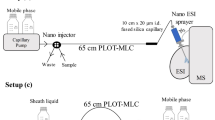Abstract
Restricted-access reversed-phase non-particulate (continuous bed or monolithic) stationary phases of different hydrophobicity synthesized in 100 μm i.d. fused silica capillaries have been evaluated. A specific property of restricted-access media (RAM) is that they interact with small analytes and exclude big molecules, e.g. proteins, from access to the active sites and adsorption on the surface. This dual property facilitates direct injection of biological fluids for drug or drug-metabolite analysis. Different RAM and RAM-precursor capillary columns were tested to assess the influence of chromatographic bed morphology on loadability. Inverse size-exclusion chromatography was used for investigation of pore structural properties of the capillary-format continuous beds. The data obtained were used to discuss the mechanism of separation of the biological samples using capillary columns and to propose a model for the topochemical architecture of the RAM investigated. Different morphology of the non-particulate reversed-phase precursors resulted in two types of RAM material shielded with hydrophilic polymer, classified as homogeneous or heterogeneous topochemistry stationary phases. Capillary columns were applied for chromatography of biological fluids. High resolution was obtained, without the need for column switching, when capillary columns operated in gradient conditions. Extensive evaluation of the chromatographic properties (hydrophobicity, efficiency, separation impedance, and loadability) of the non-particulate reversed-phase materials was performed before and after shielding with hydrophilic polymer to generate restricted-access properties. Minor changes of hydrophobicity, efficiency, or separation impedance were observed after the shielding.









Similar content being viewed by others
References
Majors RE (1991) LC–GC 686:4–9
Boos KS, Rudolphi A (1997) LC–GC 15:602–611
Rudolphi A, Boos KS (1997) LC–GC 15:814–823
Unger KK (1991) Chromatographia 31:507–511
Anderson DJ (1993) Anal Chem 65:434R–443R
Westerlund D (1987) Chromatographia 24:155–164
Kudirkaite V, Butkute S, Machtejevas E, Kornyšova O, Westerlund D, Maruška A (2001) Chemine Technologija 19:65–71
Maruška A (2003) In: Svec F, Tennikova TB, Deyl Z (eds) Monolithic materials. Preparation properties and application. Elsevier, Amsterdam, pp 141–170
Hjertén S, Liao JL, Zhang R (1989) J Chromatogr 473:273–275
Li YM, Liao JL, Zhang R, Henriksson H (1999) Anal Biochem 267:121–124
Gorbunov AA, Solovyova LY, Pasechnik VA (1988) J Chromatogr 448:307–332
Ishizuka N et al. (2002) J Chromatogr A 960:85–96
Acknowledgements
The work was supported by the Royal Swedish Academy of Sciences (Sweden).
Author information
Authors and Affiliations
Corresponding author
Rights and permissions
About this article
Cite this article
Jarmalavičienė, R., Kornyšova, O., Westerlund, D. et al. Non-particulate (continuous bed or monolithic) restricted-access reversed-phase media for sample clean-up and separation by capillary-format liquid chromatography. Anal Bioanal Chem 377, 902–908 (2003). https://doi.org/10.1007/s00216-003-2244-z
Received:
Revised:
Accepted:
Published:
Issue Date:
DOI: https://doi.org/10.1007/s00216-003-2244-z




